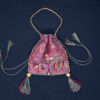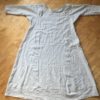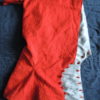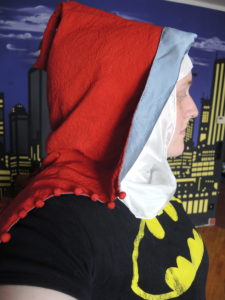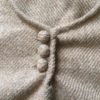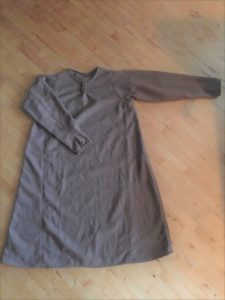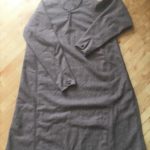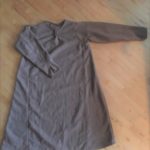Blog
I want to show you another tablet woven piece of mine which I made for a young interpreter colleague of mine.
I already collected the evidence for silk filets in this article of mine.
Just a short documentary entry for a little textile shenanigan:
Shortly on the wording: For the main undergarment in medieval times, there is a multitude of words in use. Chemise, Smock, Pfait, Hemd, Hemed, Wat etc. I will switch between Smock and Underdress here, in Austria, the best word to use would be ‘Pfoad’.
Since my old smock that I had for about 8 years, had been getting quite worn, the seams hat been tearing and the hem was already an ugly brown from all the mud it encountered over the years, at some point, and washing did not help against the discoloration any more, I had taken it apart completely and made a supportive underdress from it. I did unfortunately not write an article about it, but if you are interested in the construction you can see a bit more about those underdresses here.
So I only had two sleevless underdresses for the last two years or so which is nice for hot summer days, but a long-sleeved underdress has its merrits, it keeps you from sweating too much and makes for more warmth in winter.
So I had to have a new sleeved underdress.
Go on, this last one I still need to do for the #pluckingroses Challenge. :-D
Here is my impression of a “secret woman” from the second half of the 14th century.
When reconstructing medieval life, especially medieval clothing, one needs to maintain a fine balance. Especially if one is not 20 any more, you have more options for going about your impression. Because there were without question those who did not follow the latest fashion, those who work hard, who are very religious or who generally follow more conservative views of fashion. We know of those people when we read moral texts from our period, when we read sumptuary laws, inheretance registers and mundane letter correspondences.
But the decision, which elements to choose for a certain point in time and a certain region in order to appear conservative or fashion-forward, is difficult. You choose between profane and religious art, between what moral writers condemn and what they propagate, between local tradition and foreign influence.
At the moment I am planing a very unusual surcot for my 1350s wife of a well-off crafter. When researching, I did however come across many overdresses that were quite conservative, loose cut and not exactly what other countries in this time already had to offer. So without question, there was still a large trend for that kind of clothing in my area as well.
So I decided, in order to extend my repertoire, i should also make a version of a surcoat that mirrors this world view and started an inbetween project.
I already own a warming hood with buttons for my simple impression and if it really needs to be very practical for work, I also like to wear my husbands hood. But I wasnt quite satisfied with the fit of my buttoned hood and the material didnt really fit my more expensive clothing more expensive clothing. So I needed another model which can be worn over a fine veil and as a fashionable accessory rather than be a warming garment for winter when I most probably will never take out my finer gowns with their overlength and delicate silk lined skirt edges.
More pictures, less text this time:
(more…)
A dear friend still needed a very simple working-outfit for his wood workers impression. We still had this natural brown 2/1-twill ready which is quite robust.
I showed you some of the basics to making simple kyrtles for this time in this article here. It is really just two rectangles for the front and the back and 4 triangle shaped side gores. The tight fitting neck opening is closed with 3 fabric buttons and the arms are closed with one fabric button.
Obviously, all seams are handsewn and hae a butterfly refinements.
My original plan was to make a “normal” round-knit hairnet for a man. I had seen the hairnet exhibited in the Germanisches Nationalmuseum Nürnberg, which was described to be a Men’s hairnet . I made a joke about it to my colleague Karl (“Höhö, a men’s hairnet, I will make it if you wear it!”) and became dire reality when Karl agreed to let his hair grow so we can try this.
But when I researched the original more, the museum told me, that there had been a flooding of the particular tomb this hairnet was found in and that all the contents got mixed and that one could not be sure this is really a man’s, which is also written in the newest publications on the piece. But the hair was grown and it wanted to be held!!
This year, at the medieval days in Bad Windsheim, the topic was early 14th century in our part of the open air museum. I urgently needed more layers against the cold in the unheated original medieval houses.
So I did some research into sleeveless surcoats that would fit the time around 1320-40 as a representative dress for Sundays and a rather more simple household (this discussion is really a tedious one, since the question as to what is considered “simple” or “wealthy” and how poor a crafter would be or how rich a nobleman, what is considered a “maid” or “citizen” is very difficult to answer, so I have become careful in using those words.).





